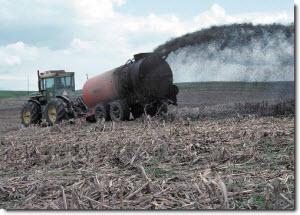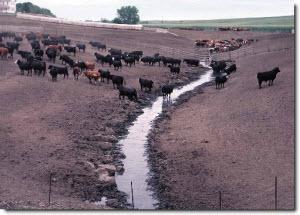The Sources and Solutions: Agriculture


Farming operations can contribute to nutrient pollution when not properly managed. Fertilizers and animal manure, which are both rich in nitrogen and phosphorus, are the primary sources of nutrient pollution from agricultural sources. Excess nutrients can impact water quality when it rains or when water and soil containing nitrogen and phosphorus wash into nearby waters or leach into ground waters.
Fertilized soils and livestock can be significant sources of gaseous, nitrogen-based compounds like ammonia and nitrogen oxides. Ammonia can be harmful to aquatic life if large amounts are deposited to surface waters. Nitrous oxide is a potent greenhouse gas.
There are many ways that agricultural operations can reduce nutrient pollution, including:
- Watershed efforts: The collaboration of a wide range of people and organizations often across an entire watershed is vital to reducing nutrient pollution. State governments, farm organizations, conservation groups, educational institutions, non-profit organizations, and community groups all play a part in successful efforts to improve water quality.
- Nutrient management: Applying fertilizers in the proper amount, at the right time of year and with the right method can significantly reduce the potential for pollution.
- Cover crops: Planting certain grasses, grains or clovers can help keep nutrients out of the water by recycling excess nitrogen and reducing soil erosion.
- Buffers: Planting trees, shrubs and grass around fields, especially those that border water bodies, can help by absorbing or filtering out nutrients before they reach a water body.
- Conservation tillage: Reducing how often fields are tilled reduces erosion and soil compaction, builds soil organic matter, and reduces runoff.
- Managing livestock waste: Keeping animals and their waste out of streams, rivers and lakes keeps nitrogen and phosphorus out of the water and restores stream banks.
- Drainage water management: Reducing nutrient loadings that drain from agricultural fields helps prevent degradation of the water in local streams and lakes.
